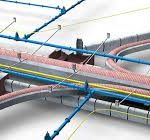Course Overview:
The “Bridge and Tunnel Engineering Techniques” course covers the principles and advanced methods in the design, construction, and maintenance of bridges and tunnels. This course aims to equip participants with the knowledge and skills necessary to understand the technical challenges associated with bridge and tunnel projects and to apply modern engineering techniques in the development of these critical infrastructure elements.
Course Objectives:
- Understand the scientific and engineering foundations for designing bridges and tunnels.
- Learn about the different types of bridges and tunnels and the techniques used in their construction.
- Acquire skills in using engineering software for analyzing and designing bridges and tunnels.
- Study the latest advancements in construction materials and technologies used in bridge and tunnel projects.
- Develop the ability to manage bridge and tunnel projects efficiently, including environmental and economic assessments.
Training Content:
- Introduction to bridge and tunnel engineering.
- Types of bridges (concrete, steel, suspension, etc.) and their designs.
- Methods of tunnel construction (cut-and-cover, shield tunneling, etc.).
- Structural analysis techniques for bridges and tunnels.
- Use of engineering software in design (such as AutoCAD, SAP2000, and ANSYS).
- Case studies of ongoing or completed projects.
- Maintenance strategies and structural evaluation of bridges and tunnels.
- Environmental and social aspects related to bridge and tunnel projects.
Target Audience:
This course is designed for civil and structural engineers, architecture students, researchers in transportation and infrastructure engineering, project managers, and technical engineers seeking to enhance their skills in the design, construction, and maintenance of bridges and tunnels. It is also suitable for urban planning and sustainable development officials.






